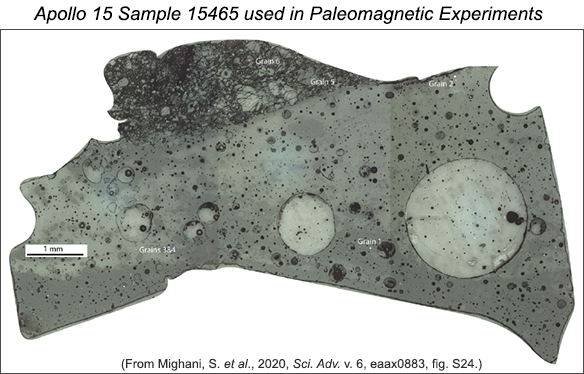Quick Views of Big Advances
No More Global Moon Magnetic Field — When Did the Lunar Dynamo Shut Off?
Among the significant outcomes from early laboratory studies of the returned Apollo lunar samples was the discovery of remnant rock magnetization—evidence of an ancient global magnetic field generated by a core dynamo. The discovery helped confirm the long-standing issue of whether the Moon had differentiated but also opened a new set of important questions, such as what powered and sustained a lunar dynamo on this relatively small body? How strong were the magnetic fields? And importantly—because the Moon no longer has a global magnetic field—when did the lunar dynamo shut off? Understanding the lifetime of the lunar dynamo is a hot topic.Decades of lunar sample studies have shown that around four billion years ago an ancient core dynamo generated a lunar magnetic field rivaling the intensity at present-day Earth's surface (~20 to >60 microteslas). Quite an amazing feat for such a relatively small body. Then around 3.2 billion years ago, the Moon's global magnetic field weakened dramatically to something less than 5 microteslas, and lasted until about 2.5 billion years ago. Then what happened?
New work reported by Saied Mighani (MIT), Huapei Wang (MIT, China University of Geosciences, Wuhan), and colleagues from MIT, UC Berkeley, and the Berkeley Geochronology Center directly addresses the question of when the lunar dynamo likely came to an end. They studied young Apollo 15 breccias 15015 (~0.91 billion years old) and 15465 (~0.44 billion years old). Their measurements show the lunar magnetic field was very likely below 0.08 microteslas about one billion years ago and below 0.06 microteslas about 0.44 billion years ago. Intensities so weak that when combined with previous estimates of paleomagnetic intensities Mighani and colleagues suggest that the lunar dynamo was likely shut off sometime between about 1.9 and 0.8 billion years ago.

|
Reflected plane-polarized light image of a thin section of Apollo 15 sample 15464,114 used by Mighani and colleagues in paleomagnetic-intensity experiments. They analyzed metal grains, the magnetization carriers, in the darker clast fragment (top section) and in the matrix glass (bottom part). Scale bar is 1 millimeter. |
The team addressed the question of what powered the lunar dynamo, especially since it now appears to have lasted longer than previously regarded. They compared the paleomagnetic intensities they measured for their two Apollo breccias and those of 15 previously measured Apollo samples to the epochs of lunar dynamo activity proposed by six different ideas of dynamo mechanisms. Mighani and coauthors list the six ideas with primary-references in their paper, but for those curious for a peek they are, "thermal convection in a dry mantle, impact-driven changes in mantle rotation, thermal convection in a dry mantle covered by a thermal blanket, thermal convection in a wet mantle, lunar precession, and core crystallization." Each proposed mechanism has a duration for powering the lunar dynamo. Mighani and colleagues' data support the idea of core crystallization driving the lunar dynamo expecially during its later billion years. In this core-crystallization scenario, explained by cosmochemist Kevin Righter (NASA Johnson Space Center) and coauthors (see reference below), the Moon's iron/nickel core (which included small amounts of sulfur and carbon) had a solidifying inner part and molten outer part, with the heat released by the crystallizing inner core providing a long-lived power source for the lunar dynamo.
![]() (pdf version)
(pdf version)
See Reference:
· Mighani, S., Wang, H., Shuster, D. L., Borlina, C. S., Nicholds, C. I. O., and Weiss, B. P. (2020) The End of the Lunar Dynamo, Science Advances, v. 6:eaax0883, doi: 10.1126/sciadv.aax0883. [article]
See also:
· Righter, K., Go, B. M., Pando, K. A., Danielson, L., Ross, D. K., Rahman, Z., and Keller, L. P. (2017) Phase Equilibria of a Low S and C Lunar Core: Implications for an Early Lunar Dynamo and Physical State of the Current Core, Earth and Planetary Science Letters, v. 463, p. 323-332, doi: 10.1016/j.epsl.2017.02.003. [abstract]
· Shea, E. K., Weiss, B. P., Cassata, W. S., Shuster, Dd. L., Tikoo, S. M., Gattacceca, J., Grove, T. L., and Fuller, M. D. (2012) A Long-lived Lunar Core Dynamo, Science, v. 335(6067), p. 453-456, doi: 10.1126/science.1215359. [article]
· Tikoo, S. M., Weiss, B. P., Shuster, D. L., Suavet, C., Wang, H., and Grove, T. L. (2017) A Two-billion-year History for the Lunar Dynamo, Science Advances, v. 3(8), e1700207, doi: 10.1126/sciadv.1700207. [article]
· Weiss, B. P., and Tikoo, S. M. (2014) The Lunar Dynamo, Science, v. 346(6214), 1246753, doi: 10.1126/science.1246753. [abstract]
Written by Linda Martel, Hawai‘i Institute of Geophysics and Planetology, for PSRD.
|
|
[ About PSRD | Archive | CosmoSparks | Search | Subscribe ] [ Glossary | General Resources | Comments | Top of page ] |
|
January 2020
|
